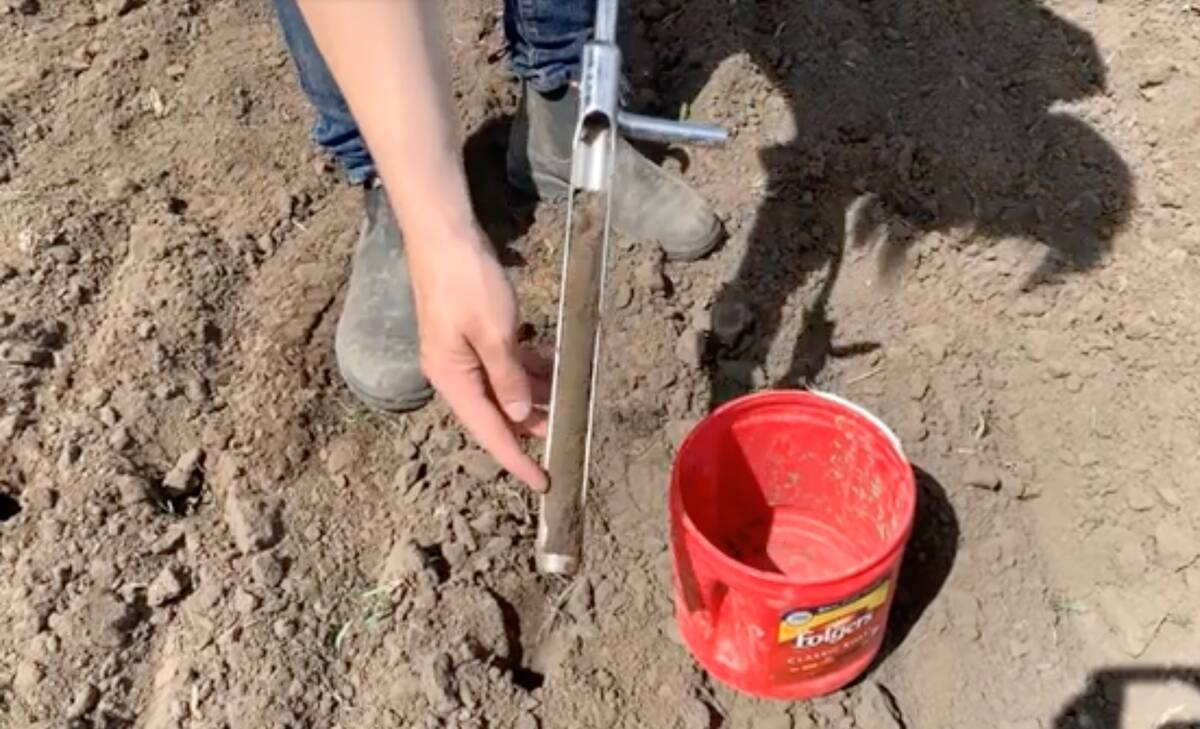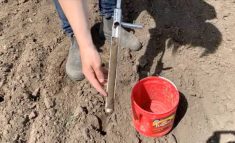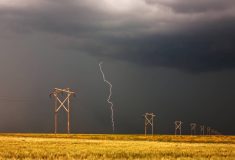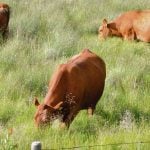For farmers, every ounce of nitrogen counts for their crop yields and their bottom line — but managing nitrogen inputs can feel like a constant battle when those inputs are lost to the air or sink below the root zone.
In a recent presentation he made at Manitoba Ag Days in Brandon, Bryce Geisel, a senior agronomist with Koch Agronomic Services, tackled the issue, digging down into these loss pathways and how applying the right practices can keep nitrogen where it belongs.
“When you put it out on your field, nitrogen is eventually going to make its way into the soil. That’s where we want it to be,” Geisel says, adding that from that point, the nitrogen would either be taken up by the plant or it would be lost to various mechanisms at play. Those loss mechanisms include volatilization, denitrification and leaching.
Read Also

Make a plan to achieve the four Rs of fertilizer management
Planning for 4R nutrient management must be farm-specific — that is, geared for the unique crops, cropping practices, soils and climatic conditions of the farm, researcher Ross McKenzie writes.
Volatilization
Volatilization occurs when urea, an inaccessible form of nitrogen for plants, is converted into ammonia and evaporates into the atmosphere. For this conversion to happen, Geisel explains, three factors are needed: urea application, water for hydrolysis, and the urease enzyme, which breaks down urea.
“The urease enzyme is broken down from residues in the crop or microbes in the soil,” he explains. “It’s pretty much everywhere, so we know we are going to have urease enzyme in your soil.”

Ammonia volatilization is most common at the soil surface and can be reduced by incorporating urea into the soil or relying on rainfall to wash it down. Factors such as soil moisture, pH, temperature, soil type and the presence of crop residue influence the extent of volatilization. For instance, high pH and lighter soils increase volatilization risk, while warmer temperatures speed up the conversion.
Leaching
Leaching happens when nitrate moves down through the soil with water, beyond the root zone. Sandy soils are especially prone to leaching after heavy rain or irrigation. This can cause nitrogen loss, particularly in fields with tile drainage. To reduce leaching, it’s important to delay the conversion of ammonium to nitrate, which allows more nitrogen to remain in forms accessible to plants before water carries it away.
“Leaching is just kind of that movement of nitrate down through the soil and out of the growing zone, the root zone of your crop,” Geisel explains. “And denitrification is going the other way.”
Denitrification
When soils are waterlogged, and oxygen becomes scarce, denitrification occurs. In these conditions, certain bacteria begin using nitrate — the nitrogen from fertilizers — instead of oxygen. As a result, some of the nitrate is broken down and lost to the atmosphere, meaning it’s no longer available for crops. This process is most likely to happen when the soil is about 60 per cent saturated, which is wet enough to limit oxygen. For farmers, this means if fields remain too wet for too long, nitrogen losses can occur, reducing the effectiveness of fertilizer and potentially affecting crop yields.
“We want to delay that nitrogen becoming nitrate as long as possible,” Geisel says. “The longer we can delay, the more likely nitrate will get to the crop.”
READ MORE: Nitrogen, nitrates and nitrites
Limit losses with 4Rs
Geisel emphasizes that the 4Rs — right rate, right time, right place and right source — are key to reducing nitrogen losses. By focusing on these strategies, farmers can boost nitrogen efficiency, minimize waste and improve their bottom line.
Experiment with rate
Every field has a point where adding more nitrogen stops increasing yield and starts to waste resources. Finding the right rate can be a challenge. It involves balancing the crop’s needs with the risk of over-application. Geisel advises farmers to review and adjust nitrogen rates frequently.
“Everyone has a number for their fields they like to use,” Geisel notes. “It’s good to have that, but it’s also good to do a little check on how they’re doing every year.”
By testing variations, such as slightly higher or lower rates, farmers can determine if they’re using too much nitrogen or if they could push the rate for better efficiency. But Geisel advises farmers to make sure the changes implemented would be noticeable.
“I’d recommend at least a 20 per cent differential from what you were doing,” he says. “If you get into that five to 10 per cent difference on your nitrogen rate, there’s a good chance you aren’t going to pick that up within the field.”
Experiment with timing
Finding the optimal timing for nitrogen application is a complex task, largely due to the unpredictable nature of weather and varying crop needs.
Geisel points out that grass crops such as wheat, barley, corn and oats require a steady supply of nitrogen throughout their growth stages. He also lumped potatoes in with that group, because they tend to need nitrogen later in the season.
Canola, though, requires nitrogen much earlier in its life cycle, which adds another layer of complexity and makes it trickier to experiment with, he says.
“But one thing that is consistent with all the crops was that the small seedlings were not taking up a lot of nitrogen.”
This creates a risk for nitrogen to be sitting unused on the soil, where it becomes vulnerable to losses — but it also creates an opportunity, allowing for adjustments so the crop can access the nitrogen once the plants begin their rapid growing phase, and nitrogen losses are less of a concern.
Geisel stresses the importance of carefully managing application timing, suggesting farmers experiment with different strategies, such as split applications, to better align nitrogen availability with crop needs. However, he acknowledges, the daily grind of the growing season also poses challenges.
“The efficiency of your operation is going to come into play, as well,” he says. “Once the field season gets going, trying to do multiple applications across the field becomes very difficult, logistically.”
Experiment with placement
Nitrogen placement offers more control than either timing or rate, with various application methods available to optimize efficiency and minimize losses.
One of the most commonly used placements is spring broadcast urea, which allows farmers to cover large areas quickly. However, Geisel points out, this placement comes with a significant risk of volatilization, especially if the nitrogen was not incorporated into the soil soon after application. The risk is particularly high when rainfall was insufficient. Ideally, a half inch or more of rain is needed to push the nitrogen into the soil and reduce volatilization losses. Without enough rain, volatilization can significantly reduce the effectiveness of the applied nitrogen, Geisel notes.

Shallow banding, a technique where nitrogen is placed just below the soil surface — typically up to two inches deep — offers a more controlled approach. This method has become popular for urea because many seeders were designed to handle side- or mid-row banding. While shallow banding reduces volatilization compared to surface broadcasting, it still carries risks, such as losses from denitrification and, to a lesser degree, volatilization, depending on soil conditions and weather.
Deep banding, where nitrogen is placed three inches into the soil, is considered the best method for minimizing nitrogen loss. This method substantially reduces volatilization and denitrification risks by keeping nitrogen at a depth where it’s less vulnerable to environmental factors.
“When we got that nitrogen down three inches into the soil, there is very little that’s going to be lost from denitrification or volatilization, but leaching is still a risk,” Geisel says.
However, deep banding can be costly and often slower, which can make it less attractive for some farmers.
Geisel also touched on the role of soil pH in nitrogen placement. Higher pH levels reduce the risk of ammonium volatilization, which occurs when nitrogen is left exposed at the soil surface.
He cautioned that pH typically increases when urea is placed in the soil, so farmers have to be aware of that dynamic as well. If the nitrogen is placed too shallowly or is not properly incorporated, the pH spike could lead to higher volatilization rates, undermining the effectiveness of the fertilizer.
Experiment with source
Geisel underscores the importance of choosing the right nitrogen source in minimizing nitrogen losses.
“Source is definitely something that gets a lot of focus in terms of nitrogen management,” he says. “We can start to play around with it and start making them more effective just by choosing a different source.”
But rather than focus on all of the different fertilizer sources, Geisel zeroes in on the nitrogen sources that have been developed specifically to reduce nitrogen losses.
Polymer-coated urea falls into that category. It consists of urea granules coated in a polymer that delays the release of nitrogen, ensuring it’s available during critical growth stages.
“It is activated by moisture, temperature, and time,” Geisel explains.
While this product reduces volatilization risk, crops still face the risk of loss from denitrification and leaching, especially if it’s applied near the surface. Geisel advises moving it deeper into the soil to mitigate these risks.
Geisel also discussed enhanced-efficiency nitrogen (EEN) products, which include both single and dual inhibitors. Single inhibitors include urease and nitrification inhibitors.
Urease inhibitors block the enzyme responsible for converting urea into ammonia.
“We want to make sure we put enough of that product down, or it’s not going to have an impact on that bacteria,” he said.
Urease inhibitors, such as NBPT, help keep urea stable longer, reducing nitrogen losses. Higher concentrations of the inhibitor lead to more effective protection and give crops more time to access the nitrogen.
Nitrification inhibitors, such as DCD (dicyandiamide), delay the conversion of ammonium into nitrate, keeping more nitrogen in its stable, ammonium form.
“What we were trying to do here is basically just run interference,” Geisel says.
These inhibitors help ensure nitrogen remains available for crops by delaying nitrification until the plants can use it.

Dual inhibitors combine the benefits of both urease and nitrification inhibitors, offering more protection against all loss mechanisms, especially in high-risk scenarios like fall applications.
“A lot of this has to be a balance between the economics, the efficiencies, and the losses that you are looking at,” Geisel says.
To a great extent, using 4R techniques to make nitrogen efficiency adjustments require an element of trial and error. Geisel stresses that the 4Rs don’t have to be treated in isolation.
“We can incorporate a source with a timing, with a rate; they’re all tied together,” he says. “That is the big takeaway.”
















